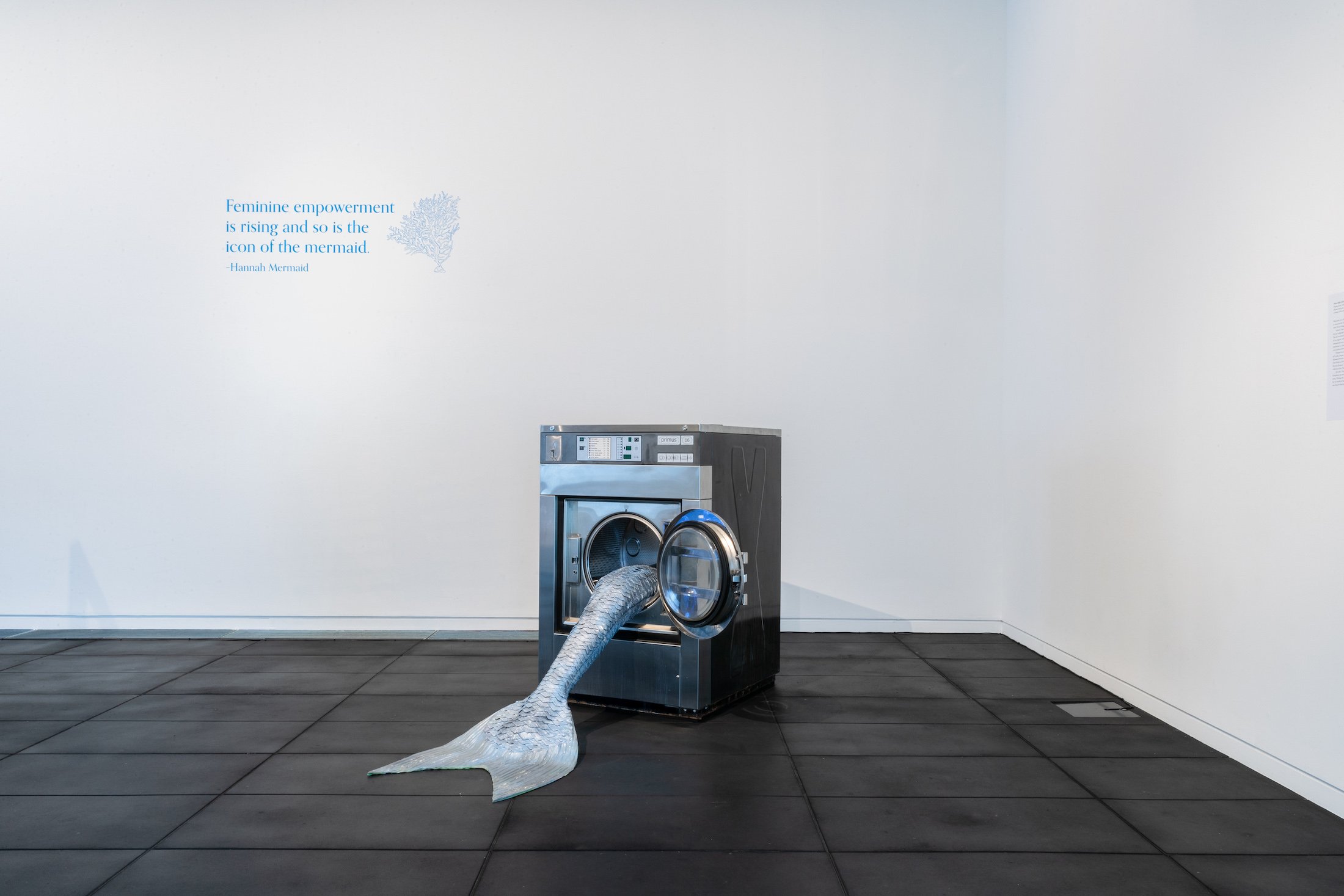Spin Cycle
“My brain is geared to creating puzzles, but they’re inverted because I’m making all the pieces and I don’t necessarily know the final image I’m putting together.”
— Olivia Erlanger in conversation with Cultured Mag
Olivia Erlanger, Pergusa (Gris), 2020. Installation view, Adam Art Gallery Te Pataka Toi, November 2022.
The Mermaid Chronicles explores the meaning and manifestations of the mermaid in culture today. For two years I skyped people who perform as professional and recreational mermaids and visited LA in 2018 to interview key professional merfolk. During my trip, I kept being sent a link to a yellow mermaid tail protruding from a washing machine. The image was of New York-based artist Olivia Erlanger’s installation Ida, first staged at Laundry Zone in Arlington Heights before going viral on Instagram. Erlanger has since made iterations of her mermaid tail sculptures for Frieze New York (2019), the Daelim Museum, Seoul (2020), and Kistefos Museum, Norway (2021). One is also in the permanent collection of the Dallas Museum of Art; and Pergusa (Gris) (2022) was made especially for The Mermaid Chronicles.
In the following interview, I speak to Erlanger about Pergusa (Gris) and the other ideas that inform the exhibition.
Olivia Erlanger, Pergusa (Gris), 2020. Installation view, Adam Art Gallery Te Pataka Toi, November 2022.
Megan Dunn: To me Pergusa (Gris) speaks to the industrialisation and commodification of our dreams, as well as perhaps the congestion of our oceans and our lives—overstuffed with products. When and how did the laundromat arrive in your mind as a key focus for your original mermaid tail installation?
Olivia Erlanger: The laundromat was kismet. It came out of a conversation with curators Milo Conroy and Jared Madere who ran MotherCulture. I began with the desire to make a mermaid tail sculpture, and after speaking to Milo and Jared, we realised the laundromat was the right environment to stage the project. Once the tails were installed inside a washing machine, I realised they were discrete sculptures unto themselves, intrinsically connected.
Pergusa (Gris) is like a puzzle. The audience has a big reaction to it—it’s very much about the tail, but equally about its surreal protrusion from the industrial washing machine. What are some of your favourite reactions to the mermaid tail works from audiences? Why do you think Ida became so instagrammable?
The best reactions were the non-reactions. Specifically, I’m thinking of when the work was originally staged in an active laundromat in Mid City, Los Angeles. Life in LA is so surreal to begin with, so some people would just kind of walk around the tails as if it was the most mundane, everyday occurrence, while others, especially children, would freak out. In regards to Instagram, I think there's been such a large response because the sculpture is asking the audience a question and telling them the answer all at once—like a New Yorker cartoon.
Ida was provoked by a child’s misreading of your earlier snake tongue sculptures. Then this year you’ve made a 12 ft long severed serpent tongue, Final Girl (Parallel Object) (2022). Many early stories of the Melusine, typically depicted as a twin-tailed mermaid, also depict her as a serpent from below. What is it about these slinky, sinewy forms that attracts you sculpturally?
The beautiful thing about a mermaid's tail is that it is almost a split phallus. I’m sure you know they are very important in terms of trans iconography, especially for young transfolks since there isn’t direct representation of non-binary genitalia. And similarly, the long sinewy tail splits. It is a “both/and'' rather than an “either/or'' shape. In terms of the snake tongue, I am very attracted to chthonic mythologies, so the snake tongue, which I was working on before the mermaid tails, continues to be a source of inspiration because snakes are at the epicenter of many origin stories.
Your recent show at Kunstverein Gartenhaus in Vienna was titled Appliance and had three elements—a play, ‘Humour in the Water Coolant’; a publication; and an installation of household appliances. I was very charmed by the creepy anthropomorphism of the cat toilet brush in the installation. The publication includes five essays you’ve written exploring the history of different appliances. What are they? And why these ones?
I wrote about the oven, washing machine, shower, toilet and refrigerator. The publication is the beginning of a larger research project in which I plan to expand on a wider swathe of industrial and household appliances. I picked these to begin with because there is a more common precedent in art and art history for these objects. It’s building on another project I did focusing on the American suburban garage, a book titled Garage (MIT Press, 2018) that I co-authored with architect Luis Ortega Govela.
The Mermaid Chronicles is curated by Megan Dunn, and runs at Adam Art Gallery Te Pataka Toi through 18 December 2022.
Further reading: Olivia Erlanger, “The Modern Shower: from Prison Control to Urban Purity,” Pin-Up Magazine.
Olivia Erlanger, Pergusa (Gris), 2020. Installation view, Adam Art Gallery Te Pataka Toi, November 2022.
Olivia Erlanger, Pergusa (Gris), 2020. Installation view, Adam Art Gallery Te Pataka Toi, November 2022.
Olivia Erlanger, Pergusa (Gris), 2020. Installation view, Adam Art Gallery Te Pataka Toi, November 2022.















Connie Brown on Simon Denny and Karamia Müller’s Creation Stories, Michael Lett, 6 August – 10 September 2022; and Gus Fisher Gallery, 6 August – 22 October 2022.